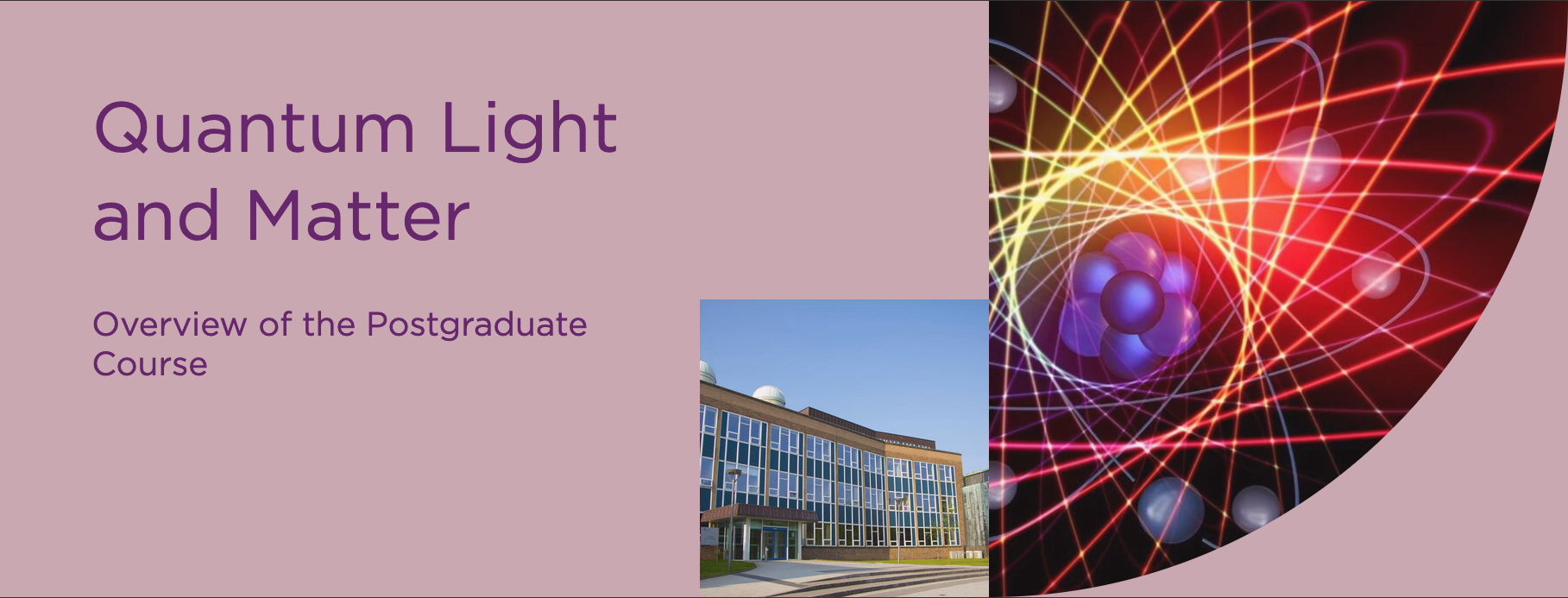
Timetable Information
Data Analysis (Dr. Lucy Downes)
Monday 11th Oct – 2pm – 3pm, Lecture 1
Monday 18th Oct – 2pm – 4pm, Lecture 2/Tutorial 1
Monday 25th Oct – 2pm – 4pm, Lecture 3/Tutorial 2
Monday 1st Nov – 2pm – 4pm, Lecture 4/Tutorial 3
Monday 8th Nov – 2pm – 4pm, Lecture 5/Tutorial 4
Monday 15th Nov – 2pm – 4pm, Lecture 6/Tutorial 5
Monday 22nd Nov – 2pm – 3pm, Tutorial 6
Atom-Light Interactions (Dr. Hannah WIlliams)
Tuesday 12th Oct – 2pm – 3pm, Lecture 1
Tuesday 19th Oct – 2pm – 4pm, Lecture 2/Tutorial 1
Tuesday 26th Oct – 2pm – 4pm, Lecture 3/Tutorial 2
Tuesday 2nd Nov – 2pm – 4pm, Lecture 4/Tutorial 3
Tuesday 9th Nov – 2pm – 4pm, Lecture 5/Tutorial 4
Tuesday 16th Nov – 2pm – 4pm, Lecture 6/Tutorial 5
Tuesday 23rd Nov – 2pm – 3pm, Tutorial 6
Atomic and Molecular Interactions: Dr. D. Carty, Dr. R. Potvliege, Prof. S. Gardiner and Prof. K. Weatherill
The aim of this course is to gain an understanding of the application of quantum mechanics, relevant to the study of atomic and molecular interactions. Including, laser cooling of atoms, interactions between pairs of dipoles, the H+2 molecule, phase shifts, and Bose-Einstein condensation and the GPE.
Timetable: sessions will be 2-4pm in PH132 (James Knott Room)
Mon Nov 29th - Gardiner
Tue Nov 30th – Carty
Mon Dec 6th - Gardiner
Tue Dec 7th - Carty
Mon Dec 13th – Potvliege
Tue Dec 14th - Weatherill
Mon Jan 10th - Potvliege
Tue Jan 11th – Weatherill
Syllabus Information
The syllabus of the Atom-light interactions course is..
- Numerical matrix representations of quantum mechanics in python: Angular momentum algebras. Solving the Schroedinger equation.
- Review of undergraduate-level atomic structure.
- Wavefunctions of alkali atoms: central potentials and quantum defects.
- Atoms in static applied fields: Stark and Zeeman effects. Numerical calculation of the Breit-Rabi diagram for alkalis.
- Atoms in dynamic applied fields: Electric dipole transitions. Selection rules. The AC Stark effect. Rabi oscillations of a two-level system.
- Open quantum systems and density matrices: Numerical treatment of open quantum systems in python
- Elements of quantum optics: Spontaneous emission. The optical Bloch equations.
- Macroscopic properties of an atomic ensemble: Resonance fluorescence. Refractive index. The Beer-Lambert law.
- Three-level systems: Electromagnetically-induced transparency (EIT). Stimulated Raman Adiabatic Passage (STIRAP).
The syllabus for the data analysis course is.
- Probability: definition, probability distributions, expectation values, random variables, error propagation, Bayes theorem
- Statistical tests: significance, goodness-of-fit, χ2-test, P-values
- Hypothesis Testing for discrete and continuous distributions
- Parameter estimation: samples, estimators, bias – mean, variance, covariance
- Central Limit Theorem
- Computer minimisation and the error matrix
More on the other courses to follow.


/prod01/prodbucket01/media/durham-university/departments-/physics/teaching-labs/VT2A9034-1998X733.jpeg)